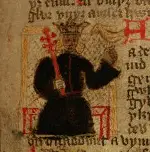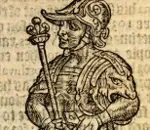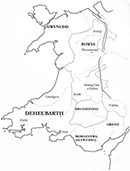Rulers of Early Medieval Wales
For most of the early years of its existence, Wales was a collection of largely Celtic tribes and then 
Through the first millennium, some rulers were powerful indeed, ruling more than one kingdom. Succession was difficult in that the Celtic custom was to pass on a ruler's lands and possessions not to the first-born son alone but to all of the ruler's sons. The first Welsh ruler who could lay claim to nearly all of Wales was Rhodri the Great (left), who was King of Gwynedd and then King of Powys in 855. Rhodri died in 878. His grandson, Hywel, came close to equaling his grandfather's feat and is known as Hywel the Good because he is credited with codifying Welsh law. 
Grufudd ap Llewelynn was the first leader who claimed leadership of all of Wales. He began as the king of Seisyll and had larger aspirations. In 1039, he seized the large kingdoms of Gwynedd and Powys in one stroke by killing Iago ab Idwal, who happened to be ruling both kingdoms at the time. Grufudd ap Llewelynn set his sights next on Deheubarth. That kingdom's ruler, Grufudd ap Rhydderch, had other plans for his kingdom and managed to hold on to it. Grufudd ap Llewelynn was back in 1055, and he was successful at taking Deheubarth this time around. The very next year, he completed the conquest of Wales by convincing Glamorgan's Cadwgan to vacate. Thus it was that in 1057, Grufudd ap Llewleynn was the ruler of all Wales. He kept hold of all of it until he died, in 1063. Emboldened by England's inattention to the area just to the east of Wales, Grufudd ap Llewelynn invaded, defeating Leofric of Mercia and then seizing large swatches of English land. The English response was delayed but finally came in the person of Harold Godwinson, Earl of Wessex. The English force hit the Welsh hard, forcing Grufudd ap Llewellyn to retreat. He ran out of options on August 5, 1063, and died at the hands of the English (and, some historians, say of his own men). Harold completed the conquest three years later, when he was named King of England, by marrying the Welsh leader's widow, Ealdgyth. He briefly had control of both England and Wales. Harold lost his crown to William the Conqueror, who nearly conquered Wales. Norman Marcher lords certainly ranged into Wales, but no English king attempted overlordship of Wales. Welsh rulers gradually took back land seized by the Normans. At the same time, no Welsh leader emerged as an interior overlord, until the 13th Century. Llywelyn ab Iorwerth (known as Llywellyn the Great) ruled Gwynedd and most of the rest of Wales, and a contemporary source lists him as ruler of all Wales. His son, Dafyd, took the title himself in 1244. 
Llewelynn ap Gruffudd, later known as the "Our Last Leader," became King of Gwynedd in 1255. Llewelynn had such a powerful presence and a powerful army that the other three large kingdoms–Deheubarth, Glamorgan, and Powys–recognized Llewleynn as their leader as well. Llewellyn functioned as the leader of Wales when he signed the Treaty of Montgomery with England's King Henry III in 1267. Llewelynn agreed to pay homage to Henry, who named Llewelynn Prince of Wales. Llewelynn had no such relationship with Henry's son and successor, King Edward I, who eventually declared war on Llewelynn. The English army that invaded Wales in the late 1270s was very large, and the result was that Llewelynn in 1277 surrendered a good amount of land to Edward, who promptly built a number of castles in order to maintain English control. Llewelynn eventually rebelled, and the fighting carried on. Llewelynn died in battle in 1282, and his brother Dafyd carried on the struggle. Dafyd didn't fare much better, being defeated and captured in June 1283 and then executed by Edward in October. The victorious Edward declared himself leader of the Welsh and imposed English law on the Welsh people. The Statute of Rhuddlan, in 1284, declared Wales to be not an independent land but a set of counties, to be governed by English officials who answer to the English Crown. In addition to the construction of yet more castles, Edward had built a number of towns. In 1301, Edward named his son, also named Edward, Prince of Wales. |
|
Social Studies for Kids
copyright 2002–2025
David White



 kingdoms. Roman soldiers eventually conquered Wales but then left a bit abruptly. Anglo-Saxon invaders took over England and some of Wales, and Danish invaders advanced on Welsh positions from both east (England) and west (Ireland); but by and large, Wales after Rome was left to advance according to its own devices. By the time of the
kingdoms. Roman soldiers eventually conquered Wales but then left a bit abruptly. Anglo-Saxon invaders took over England and some of Wales, and Danish invaders advanced on Welsh positions from both east (England) and west (Ireland); but by and large, Wales after Rome was left to advance according to its own devices. By the time of the 
